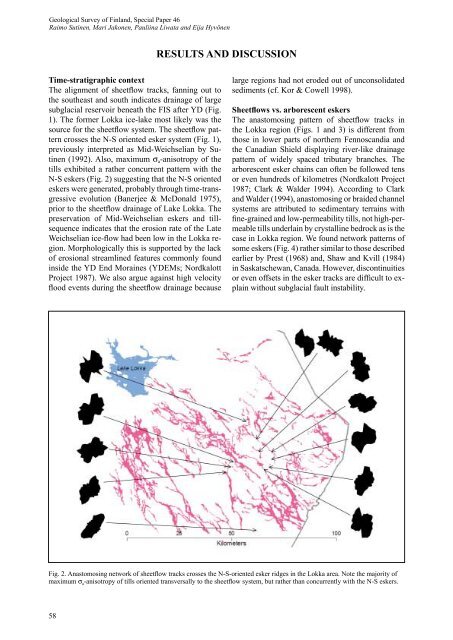Geological Survey of Finland, Special Paper 46 - arkisto.gsf.fi
Geological Survey of Finland, Special Paper 46 - arkisto.gsf.fi
Geological Survey of Finland, Special Paper 46 - arkisto.gsf.fi
You also want an ePaper? Increase the reach of your titles
YUMPU automatically turns print PDFs into web optimized ePapers that Google loves.
<strong>Geological</strong> <strong>Survey</strong> <strong>of</strong> <strong>Finland</strong>, <strong>Special</strong> <strong>Paper</strong> <strong>46</strong><br />
Raimo Sutinen, Mari Jakonen, Pauliina Liwata and Eija Hyvönen<br />
Time-stratigraphic context<br />
The alignment <strong>of</strong> sheetfl ow tracks, fanning out to<br />
the southeast and south indicates drainage <strong>of</strong> large<br />
subglacial reservoir beneath the FIS after YD (Fig.<br />
1). The former Lokka ice-lake most likely was the<br />
source for the sheetfl ow system. The sheetfl ow pattern<br />
crosses the N-S oriented esker system (Fig. 1),<br />
previously interpreted as Mid-Weichselian by Sutinen<br />
(1992). Also, maximum σ a-anisotropy <strong>of</strong> the<br />
tills exhibited a rather concurrent pattern with the<br />
N-S eskers (Fig. 2) suggesting that the N-S oriented<br />
eskers were generated, probably through time-transgressive<br />
evolution (Banerjee & McDonald 1975),<br />
prior to the sheetfl ow drainage <strong>of</strong> Lake Lokka. The<br />
preservation <strong>of</strong> Mid-Weichselian eskers and tillsequence<br />
indicates that the erosion rate <strong>of</strong> the Late<br />
Weichselian ice-fl ow had been low in the Lokka region.<br />
Morphologically this is supported by the lack<br />
<strong>of</strong> erosional streamlined features commonly found<br />
inside the YD End Moraines (YDEMs; Nordkalott<br />
Project 1987). We also argue against high velocity<br />
fl ood events during the sheetfl ow drainage because<br />
58<br />
RESULTS AND DISCUSSION<br />
large regions had not eroded out <strong>of</strong> unconsolidated<br />
sediments (cf. Kor & Cowell 1998).<br />
Sheetfl ows vs. arborescent eskers<br />
The anastomosing pattern <strong>of</strong> sheetfl ow tracks in<br />
the Lokka region (Figs. 1 and 3) is different from<br />
those in lower parts <strong>of</strong> northern Fennoscandia and<br />
the Canadian Shield displaying river-like drainage<br />
pattern <strong>of</strong> widely spaced tributary branches. The<br />
arborescent esker chains can <strong>of</strong>ten be followed tens<br />
or even hundreds <strong>of</strong> kilometres (Nordkalott Project<br />
1987; Clark & Walder 1994). According to Clark<br />
and Walder (1994), anastomosing or braided channel<br />
systems are attributed to sedimentary terrains with<br />
<strong>fi</strong> ne-grained and low-permeability tills, not high-permeable<br />
tills underlain by crystalline bedrock as is the<br />
case in Lokka region. We found network patterns <strong>of</strong><br />
some eskers (Fig. 4) rather similar to those described<br />
earlier by Prest (1968) and, Shaw and Kvill (1984)<br />
in Saskatschewan, Canada. However, discontinuities<br />
or even <strong>of</strong>fsets in the esker tracks are dif<strong>fi</strong> cult to explain<br />
without subglacial fault instability.<br />
Fig. 2. Anastomosing network <strong>of</strong> sheetfl ow tracks crosses the N-S-oriented esker ridges in the Lokka area. Note the majority <strong>of</strong><br />
maximum σ a-anisotropy <strong>of</strong> tills oriented transversally to the sheetfl ow system, but rather than concurrently with the N-S eskers.

















